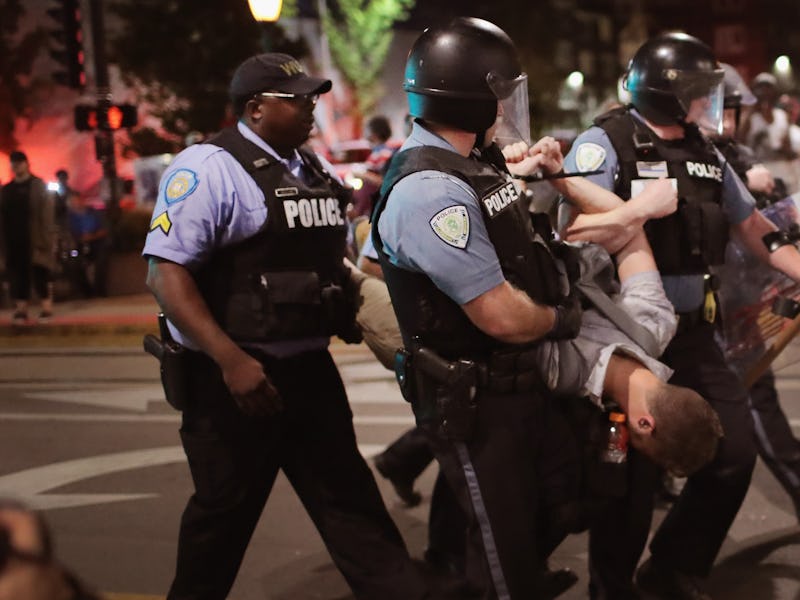Harvard Study Shows Actual Number of People Killed by U.S. Police
"The public needs better data about who is being killed."

In a revelatory new study published Tuesday, Harvard public health researchers report that in 2015, a total of 1,166 people were killed by police in the United States. What’s staggering about this research is not just the massive number of police killings it reports — and knowing that many of those police aren’t disciplined, — but the fact that scientists were able to conduct the study at all. Historically, the U.S. government has been unable to provide a full count of people killed by police that has the confidence of federal statisticians.
This new study, published Tuesday in PLoS Medicine, is the first to quantify the undercounting of police-related deaths in both a nationwide death certificate data and in a news media-based database — which makes it the most accurate count the public has to date.
People deserve to know how many people have actually been killed by police, study co-author Justin Feldman tells Inverse. They also deserve to see that information, he adds, in an accurate way from a credible source.
“There’s also a narrower message directly to the public health community, which is that we are already responsible for collecting data on causes of death, and we’re not doing a good job in this particular instance,” says Feldman, a social epidemiologist and a doctoral candidate at the Harvard T.H. Chan School of Public Health.
“There are ways to improve reporting, like integrating local news reports of people being killed by police into public health data and doing more work to figure out what is going on in terms of death not being accurately reported on death certificates.”
Law-enforcement related death misclassification rates by state.
There’s no reliable system that tracks law enforcement-related deaths, so the Harvard team had to use data from two incomplete lists: the U.S. Centers for Disease Control’s National Vital Statistics System, which is based on state death certificate data, and a data set based on news stories and crowdsourced information compiled by The Guardian called “The Counted.”
To come to a number of total killings, the researchers used a statistical analysis technique called “capture recapture.” By analyzing how many cases of people killed by police were reported in only The Guardian’s data, only in the CDC data, or in both, they were able to extrapolate the number of the deaths not captured in both data sets. In this case, it appeared that The Guardian documented 93 percent of deaths, while the CDC only documented 44.9 percent.
“Then we add all those together to get 1,166,” says Feldman. “There’s a confidence interval around that — it’s give or take 15 deaths. That is very close.”
Two-source estimate of the total number of law-enforcement related deaths.
The data also revealed that undercounting of police-related deaths varied among states in federal data. In Oregon, for example, almost all of the 17 police-related deaths that happened in 2015 were counted, whereas none of the 36 deaths in Oklahoma were. One of the primary reasons this occurred, the researchers note, is because the coroner or medical examiner assigned to the slain individuals did not mention police involvement on their death certificate.
Undercounting, the scientists report, was more common in lower-income counties, in instances where deaths were not caused by a gun, among people under the age of 18, and among black civilians. What this means is that official death certificates failed to count more than half the people killed by police in 2015.
People march on the West Side Highway during a protest after a Grand Jury decided to not indict officer Daniel Pantaleo. Eric Garner died after being put in a chokehold by Pantaleo on July 17, 2014.
So how do we get better data? It largely comes down to holding federal systems accountable for creating a reliable system.
America has attempted to do this before: In the early 2010s, the U.S. Bureau of Justice Statistics attempted to tally killings by police but shuttered the project in March 2014 because reliable data were lacking. States are not federally required to provide this information, and many do not.
While President Barack Obama was in office, he renewed the Deaths in Custody Reporting Act, which was designed by Virginia Representative Bobby Scott to require law-enforcement agencies to report on civilian deaths that occurred during interactions with law enforcement. This legislation enabled the creation of the Arrests Related Deaths program in 2015 which was designed to integrate Department of Justice data and local news report — but it’s unclear where that program stands today with President Donald Trump.
“With the change in administration, I don’t know what’s happened to that program — even if it’s continuing, it’s not clear if the data will ever be released to researchers, reporters, or the public,” says Feldman. “I don’t know how valuable it could even be.”
What is clear, Feldman argues, is ttransparent system to provide the public with data on the number of police-related deaths that occur in a given year. There is power in counting, and knowing the truth, he says, can “better prevent suffering and death.”